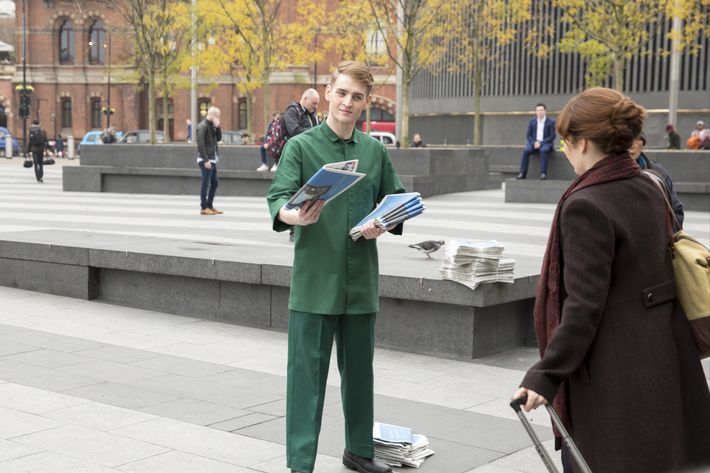
AMCÔÇÖs Humans is a British-American science-fiction series set in the present day, where human-in-appearance robots are an increasingly popular high-end gadget. A key element to selling the showÔÇÖs conceit is the strangely disconcerting physical presence of the ÔÇ£Synths.ÔÇØ Credit for how well it all works belongs not only to the cast of Synth players, headed by Gemma Chan (as Anita, a Synth housekeeper who is more than she seems) and the non-Synths who respond to them (including William Hurt as an elderly scientist), but to movement director Dan OÔÇÖNeill.
OÔÇÖNeill, a former dancer and choreographer (currently directing a production of Carmen in Athens, Greece), was on set for every day of shooting for the eight-episode series, training the cast in uniquely fluid and graceful movements developed in his so-called ÔÇ£Synth school.ÔÇØ
How did ÔÇ£Synth schoolÔÇØ come about?
There was a great background pamphlet that [detailed] all the different levels of sophistication in these machines. But we realized that they would all have some standard traits in common. So we began working with some of the performers to develop some ideas, then Sam [Donovan,┬ádirector of the first two episodes] came in, and we discussed how weÔÇÖd do that with the cast ÔǪ this sort of way in, which they all called ÔÇ£Synth school,ÔÇØ which has a nice ring to it.
I met Gemma Chan and Will Tudor [who plays Odi, HurtÔÇÖs early model, slightly malfunctioning Synth] initially and took them through the work IÔÇÖd been doing, and we worked on those ideas and developed a way of how these machines would move and how they would behave.
What kind of behavior, beyond what was laid out in the script?
The key thing to me was that they would have a certain battery life, like our phones  or like a human with 16 hours of battery life a day, and then eight hours charging [time]. And that gave me a very clear indication that they need to be the most ergonomic machines that we could develop. They wouldnt expend any energy on any sort of superfluous things. Were always wasting energy, changing direction, and having a new thought  being instinctive. These machines would have no instincts. Cleaning away all that nonverbal communicating we do, like gesturing or scratching our head, indicating what we are feeling inside. These guys would never betray an interior world. So they present like humans in lots of ways, except theyre too Zen. [Laughs.]
It was a real challenge for actors, who are so used to investigating quirks and idiosyncrasies of characters, and finding traits that they can hook their characters to  I was asking them to do quite the opposite: look for commonality. I was talking to Gemma, who has been so trusting that this would work, and she said, But am I going to have a character? If I follow these rules, arent I going to vanish, in a way? And I said, No, well project character and meaning onto what youre doing, because thats what we do. Were desperate to put meaning onto things.
Did you do more detailed work with Gemma and the other ÔÇ£lead SynthsÔÇØ than for the rest?
GemmaÔÇÖs working with the wonderful Katherine Parkinson, and I [told her], ÔÇ£DonÔÇÖt respond to her as you would as an actor. Keep resisting that, keep finding a way to hold yourself in this place.ÔÇØ And conversely, I told Katherine, ÔÇ£Just be a bit more human, make yourself a bit more slumped, just be a bit more scratchy and fidgety.ÔÇØ So you get more of that counterpoint.

Will Tudor, whoÔÇÖs with the great William Hurt, has this slightly busted arm. We used that quirk, that his arm is slightly off-center. So we said, ÔÇ£YouÔÇÖre kind of obsolete, kind of breaking down a bit,ÔÇØ and we talked about ÔÇö you know when your phoneÔÇÖs charging wire gets a bit frayed and the connectionÔÇÖs not so great? I said, ÔÇ£Well, maybe he needs to move his arm to be charged, and heÔÇÖs done it so many times itÔÇÖs gotten a bit stuck in that position.ÔÇØ
It sounds like Synth school got down to body part by body part 
We did really look at each element of the body. So with the eyes  normally when we look at something, we lead with our noses and find it and focus. We did a lot of work on [Synths] leading with their eyes, and the skull kind of following. Its very, very subtle  slide the eyes, then move the head. With humans, youll be talking to someone and then start walking away, but we leave our eyes sort of trailing behind in the head and lead with the feet  and start walking off. And thats why we trip over things, because we forget theres something behind us. But these [Synths],their eyes would leave the subject, and then the head would follow, and so on. So they would make sure there wasnt a small child or a kitten in the way [laughs] to trip over. Because you wouldnt want this expensive piece of equipment to hit the floor.
ThereÔÇÖs no head tilt, no ÔÇ£curious dogÔÇØ moments. The head almost moves like a really great tripod head on a camera. We didnÔÇÖt want to be robotic and jolty, we wanted to have this lovely, smooth technology that wouldnÔÇÖt upset humans or look comical.

We also did a lot of work on the weight being centered in the feet. We started just by sitting and standing, trying to use the least amount of energy but still having the same effect. When they walk  think about a sprinter when he takes off from the blocks, hell be using the body weight, the head and the shoulders and the legs powering that weight. Theyre kind of low for the first 50 meters until they stand up. And I said [Synths] need to walk as one piece, so the head, the back, the hips, everything has to move through space as one.
The actors must have had to practice a lot in their spare time to get this right.
Id say, for homework, go home and try to be a Synth for just an hour. And partners and friends would just freak out. I got banned at home from practicing. My poor daughter was like, Please, Daddy, could you just be like a human for a bit? But it became very addictive, because youd find ways to approach each new challenge  Gemma had to walk down stairs without looking, because I calculated that she already knew the height of the stairs. In one take she just went down the stairs on her ass. [Laughs.]
Did different generations of Synths get different movement direction? Or the ones that have more independent thought than the others?
Even the old mobile phones still contain pretty much the same shape, the same keypads ÔÇö though of course things are different now with touch ÔÇö the principles are the same. The sentient Synths obviously have something else going on, but they can hide in plain sight, and just adopt the mannerisms of a regular Synth. But there are moments you see them in private, like, say, with Ivanno Jeremiah [who plays renegade Synth Max] when heÔÇÖs with Colin Morgan [MaxÔÇÖs companion Leo] where heÔÇÖs almost emoting just like us. And then as soon as heÔÇÖs back in public heÔÇÖs able to drop back into a pure synthetic mode.
The ÔÇ£pure SynthÔÇØ mode is very fluid and graceful.
If we were going to have this technology, it would also have to be at least as sexy as a MacBook Air or an iPhone 20  it needs to be desirable.
Speaking of sexiness, it doesnÔÇÖt take long before weÔÇÖre at a Synth-staffed brothel. On the surface, itÔÇÖs pure fantasy fulfillment, but it gets disturbing very quickly.
That was the hardest section, actually, when I was casting for prostitutes. And I said at one point, ÔÇ£ItÔÇÖs a bit like a peep show. YouÔÇÖre in your own little booth, make up a routine.ÔÇØ So each woman ÔÇö we even had a guy in there, which I donÔÇÖt think was ever shown ÔÇö has a way to appeal to a certain punter or a certain john, as you would say in the States, but it had to be on a loop. So itÔÇÖs a bit like a pole dance, but without them being conscious of their sexuality or of the allure theyÔÇÖre projecting. The reference IÔÇÖve used is the beginning of Sweet Charity. Fosse was really on to something there. Slightly grotesque, slightly too much.
Human, but not quite.
Not losing the machine, that was really key to me. Even in the most sentient, emotional times of these characters, that even then you can still see that they are man-made. That was the biggest challenge for me and for the actors, that we didnt lose that subtle difference  to get close to being human but not right on it. Because then we wouldnt have a show. [Laughs.]

